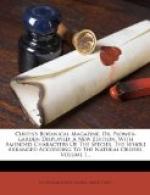We first saw it in flower, and have since seen it with ripe seed-pods, at Mr. MALCOLM’s, Kennington.
It is properly a green-house plant, and propagated only by seeds, which are to be sown on a gentle hot-bed.
It is some years in arriving at its flowering state.
[111]
LATHYRUS TUBEROSUS. TUBEROUS LATHYRUS, or PEASE
EARTH-NUT.
Class and Order.
DIADELPHIA DECANDRIA.
Generic Character.
Stylus planus, supra villosus, superne latior.
Cal. laciniae
superiores 2 breviores.
Specific Character and Synonyms.
LATHYRUS tuberosus pedunculis multifloris,
cirrhis diphyllis: foliolis
ovalibus, internodiis
nudis. Linn. Syst. Vegetab. ed. 14.
Murr.
p. 663.
LATHYRUS arvensis repens tuberosus. Bauh. Pin. 344.
LATHYRUS arvensis sive terrae glandes. Pease
Earth-Nuts. Parkins. Theat.
p. 1061.
[Illustration: No 111]
Grows spontaneously in various parts of France and Germany; Mr. PHILIP HURLOCK lately shewed me some dried specimens of this plant, which he gathered in the corn fields, on the Luneburgh Heide, in Upper Lusatia, where it grew plentifully, and afforded a pleasing appearance to the curious traveller:—not so to the husbandman, to whom it is as noxious as the Convolvulus arvensis (small Bindweed) is with us, and equally difficult to extirpate, having powerfully creeping roots, which somewhat like the Helianthus tuberosus (commonly called Jerusalem Artichoke) produce large tubera, and which like those of that plant, are in high esteem with some as an article of food, and as such even cultivated abroad.
It flowers from June to the end of August. It is certainly a beautiful hardy perennial, similar to (but of more humble growth) than the everlasting pea, yet must be cautiously introduced on account of its creeping roots, by which it is most readily propagated, rarely ripening its seeds with us.
It is, perhaps, better suited to decorate the unclip’d hedge of the pleasure-ground, than the border of the flower-garden.
[112]
CISTUS LADANIFERUS. GUM CISTUS.
Class and Order.
POLYANDRIA MONOGNIA.
Generic Character.
Corolla 5-petala. Calyx 5-phyllus:
foliolis duobus minoribus.
Capsula.
Specific Character and Synonyms.
CISTUS ladaniferus arborescens ex stipulatus,
foliis lanceolatis supra
laevibus, petiolis
basi coalitis vaginantibus. Linn. Syst.
Vegetab. ed. 14.
Murr. p. 497.
CISTUS ladanifera Hispanica incana. Bauh. Pin. 467.
CISTUS Ledon. The Gum Cistus or Sweete Holly
Rose. Park. Parad. p.
422.




